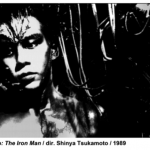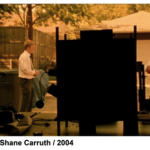SINEW SIMULACRA
(The International Symbol of the Hand & Body in Underground/Low-Budget Cinema)
That which drives us to build and to create as human beings may indeed originate from the inner self in some invisible state, but the resolution intrinsically connects itself to the vessel by which psychological impulses make themselves tangible: the human body. Our physical make-up executing and fulfilling these ever-present subconscious machinations of the human id has been a point of interest for major underground filmmakers for decades, developing itself into full-on movements with artisans looking at our relationship to our own manifestations as organisms in a myriad number of ways. That the topic and the stories that emanate as a result over time have established a pattern of mining almost exclusively dark cinematic themes is a phenomenon that could best be attributed to the fears and uncertainties that a collective populace holds regarding where the body stands in relation to the constant progression of technology starting in the mid 20th century and moving forward into the near future. Certain progenitors of low/zero-budget filmmaking are the same exact storytellers who explore subversive, body-centric allegory and serve as conduits for pontification and analysis of this posed modern question: “What role does our physical self now play in the creation of art in a modern, forward-thinking landscape?” With these foundational concepts and understandings in mind, a current audience and viewers of art across all cultures and backgrounds can begin to see and interpret the idea and place of the “hand-made” in regards to what we create from a worldview of the present time.
It is safe to say that some of the first seeds in a deeper investigation of the aforesaid themes were sown in David Lynch’s debut feature Eraserhead (1976). Since the film’s release up to today, viewers of the cult classic have imbibed from it countless messages, meanings, and commentaries. However, there are a few immutable elements within the fabric of the piece which delineate it as a perfect example of a study of the body to the environment, separate from any final statement made by Lynch as to the film’s meaning. The industrial landscape, complete with prodigious slate walls, barren pipes, and oil stains en masse engulf the “protagonist” Henry Spencer in his transit from one oddity to the next. These byzantine factors box Henry frequently into the center of the frame, creating an external steel prison that runs parallel to his internal entrapment arisen from his unexpected child, which he envisions as an abnormal bandaged mid-fetal state creature constantly emitting a shrill cry. It becomes apparent that the organic and the non-organic both originated from man’s proverbial “hands”, if you will, furnish their own individual stock-hold of moral dilemmas and everyday obstacles. These two facets of Henry’s life merge in his psychosis and connotate ideas of adult responsibility and commitment to one’s self and to one’s environment through the things that are created by human physicality. This concept can be taken as tangential to the actual making of the film, wherein Lynch spent several years in production, taking long breaks between shooting periods to accumulate funds in order to move into the next period of photography and garner materials for some of the more outlandish props (such as the aforementioned baby) in the film. In turn, Lynch’s true behind-the-scenes story can be construed as his feeling “responsible” to finish a product which came from his own hands: a creation whose life is fuelled by the efforts of the individual. Eraserhead lays the foundation for the meditation on the inner workings of the body, and by extension, the image of the hand in film and what is possible through a more home-grown approach in constructing a thought-provoking work of art through the moving image.
Lynch’s first film served as direct influence on a culture and movement which, it could be said, best embodied the principles and aesthetics associated with the more surreal visual take on the progression of the human hand and it’s anthropological offspring in society: the Japanese cyberpunk movement of the late-‘80s/early-‘90s. These up-and-coming filmmakers calling the digital wasteland of “pre-turn-of-the-century” Tokyo their home explored for better or worse the highest highs and lowest lows in regard to the possible outcomes that our man-made products could have on the entire globe, much less Japan as a single country. This willingness to travel to both ends of the tonal spectrum allowed for some particularly nightmarish perspectives, like Shinya Tsukamoto’s Tetsuo: The Iron Man (1989). Tsukamoto’s film is essentially a fable detailing the dichotomy of two diametrically opposed individuals: a junkyard dweller obsessed with the man-made and a salary-man in dire fear of it. Like Lynch, Tsukamoto opted for a very obvious hand-crafted look in approaching the special effects in his film, animating them in the same vein of the Czech surrealist stop-motion artist Jan Svankmajer. The stuttering stop-and-start non-fluidity on display in particular sequences of Tetsuo can be attributed to a mechanistic pattern which Tsukamoto observed that all individuals living within an industrial environment can fall prey to in their everyday societal lock. With close-up upon close-up of every single manufactured steel apparatus finding affixation onto the limbs of the two principles, Tsukamoto offsets this with the physical struggle of these men’s natural bodies in entropy, straining to detach the very fruits of the labor enacted by their own flesh and blood. By the picture’s close, the audience is faced with the image of the two men fused into one over-sized man-machine hybrid, their very hands finally metamorphosed wholly into mechanical weapons. This visual is an unsettling one, for certain, but it successfully encapsulates Tsukamoto’s observation that the path of our dependency on devices and materials born from our own hands is one of choice, albeit one that does not have to be made at sacrifice to the organs we were born with. The slow-burning success that Tetsuo achieved in its domestic release in Japan was proof that despite its harsh imagery, there was a public that could relate to its themes and questions. Tsukamoto would go on to move away from the fantastical in his future films such as Bullet Ballet (1998) (a character study of a man versus the expectations of a large city) and A Snake of June (2002) (an observation of a woman versus her own perceived sexuality), yet he still never let his focus stray from the central subject of the human embodiment.
While those filmmakers looking to follow in the footsteps of Tsukamoto’s style never were able to achieve the same tier of recognition, one of his contemporaries was able to see the potential in the ideas at work in Tetsuo and reinvent them to create something that followed a radically different course. That individual (who also put in time as one of the crewmembers on Tetsuo) was Shozin Fukui, who wrote and directed Pinocchio 964 (1991) with a starkly disparate set of suppositions on that which is wrought from human palms. Firstly, Fukui opted to film his piece in color, which illuminated a domain of insight that Tsukamoto intentionally left clouded through his implementation of B&W photography. This vibrancy, coupled with the vagaries of a story presented by Fukui to the viewer through an introductory montage of a sex-cyborg having his memory wiped by lab scientists only to be left out on the streets of late 20th-century Tokyo, gives way to an outset from which to start looking at the pain of human creation and handwork not from a more physical standpoint, but from a mental one. A viewer would be hard-pressed to find nary but a few hints to anything of the steel-and-iron aesthetic, as Fukui took a majority of his production to the streets, having his actors perform in front of oblivious real-world citizens who appear to be simultaneously entranced, confused, and frightened by what is taking place in front of them. The director merely uses the science-fiction parameter to frame a kinetic apperception of the most volatile quality of life that can be said to be carefully cultivated by the metaphorical hand: pure emotion present within interpersonal relationships. Once the lost cyborg Pinocchio makes contact with the female vagrant Himiko and subsequently becomes self-aware, the majority of the film’s focus then shifts to a near exclusive reverie on the latent power of emotional exhilaration giving rise in a physical outburst to spiritual independency. Pinocchio excretes what appears to be primordial ooze in his state of epiphany, giving rise to Himiko’s own brand of ultra-being in which she arrives at the subway and commits to vomitus before physically attacking Pinocchio. It is natural to expect viewers to balk at such grotesquery, but a closer inquiry reveals that Fukui’s use of semiotics at play in this late stage of the film underlies the subtext that we are witnessing an organism struggling to come into its own state of comfort in being. The final moments come together similarly to Tetsuo only in appearance; the implications have their own authenticity and uniqueness. On a reawakened rampage to meet his maker, Pinocchio finds the strength to cast off and erase the negative ramifications of his past. We return to the image of the hand a final time as Pinocchio, his hands taking on a meta-state of muscle expansion, bedrock texturing, and peak strength, rips through his creator and proceeds to decapitate Himiko, only to merge her head onto his, creating a combined life-form of a seemingly complacent and peaceful nature (i.e. Himiko and Pinocchio now co-exist as one in a mutually beneficial relationship). Pinocchio 964’s symbolic and ideological threads served as inspiration to a myriad number of consecutive moving image artists who took it and Tetsuo’s essays on the joys and dilemmas of the body into a more grounded, reality-driven backdrop. One such example is director Go Shibata’s Late Bloomer (2004), which details the life of Masakiyo Sumida (played by himself), a man disabled with cerebral palsy who lashes out at the able-bodied around him who he believes possesses life he will never have. In accordance with being a non-actor who is actually diagnosed with the disability, Sumida’s movements and mannerisms draw parallels to the beings of Lynch, Tsukamoto, and Fukui’s filmic worlds while embodying more tangibly the hopes and desires of their stories; his hands can be seen as enactors of lost passion.
We find today that the constructs of man are being realized at an increasingly accelerated and rapid pace, spiraling into a future of uncertainty for many. Yet this approaching timeframe could be seen as one of great promise for artists locally and abroad. The potential that is intrinsically poured into anything that emanates from the efforts of our mortal fingers, muscles, and tendons all functioning in conjunction to each other grants the possibility of endless attainment moving ahead. Filmmaker Shane Carruth’s psychological piece Primer (2004), filmed entirely in the Dallas, Texas area, can be looked to as a beacon for these millions of coalescing ideals, both in its making and in its subject. Financed for a low sum of $7,000 dollars, Carruth taught himself the principles of filmmaking in the few years leading up to production in order to commence the realization of the story that he carried with him in the entirety of that period. The phrase “built from the ground up” most certainly applies to Carruth’s hands-on, D.I.Y. process where each individual wears numerous hats to make the film a reality. This approach to making a film strikes reminiscent of Lynch’s grassroots, long-term production gestation and complete control over every artistic aspect of the proceedings. The concepts of control and being accountable for what is created in life are integral to understanding how the twists and turns of Primer’s parable leanings enthrall and confound in equal measure. From the introduction of the two engineers and their development of a collapsible man-built time machine to their implementation of it, eventual falling out, and paradoxical moral struggle with the alternate selves of the past, Carruth presents the ultimate consequence of the nascence envisaged through the hand of the homosapien. In a collective look back on all the discussed pivotal works, the hand is seen as destroyer, bringer of life, lightning rod of human achievement, and a symbol of responsibility to the self and the fellow man. Just as in the conclusion to Primer, wherein one of the engineers is seen rallying together a large number of workers in communion to begin work on his next project, the modern community of artists now hold the responsibility to make art in communication with the surrounding art world and join hands in dialogue on where we go from here.
- Tucker Meyers (May 15th, 2012)
- view pdf
Eraserhead / dir. David Lynch / 1976
Eraserhead / dir. David Lynch / 1976
Tetsuo: The Iron Man / dir. Shinya Tsukamoto / 1989
Tetsuo: The Iron Man / dir. Shinya Tsukamoto / 1989
Pinocchio 964 / dir. Shozin Fukui / 1991
Pinocchio 964 / dir. Shozin Fukui / 1991
Late Bloomer / dir. Go Shibata / 2004
Late Bloomer / dir. Go Shibata / 2004
Primer / dir. Shane Carruth / 2004
Primer / dir. Shane Carruth / 2004













